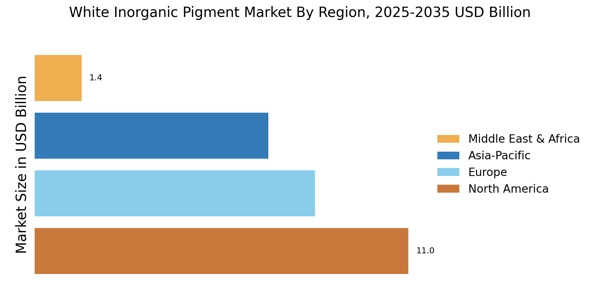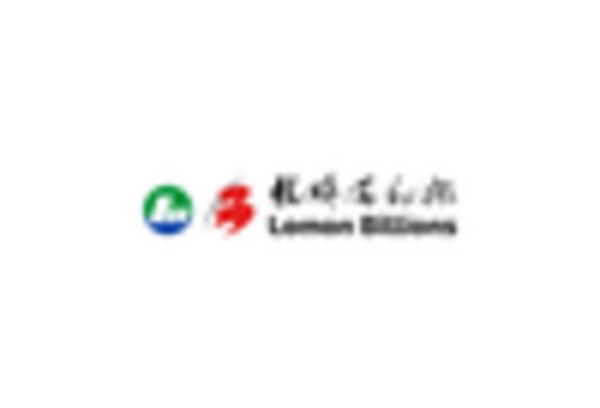Growth in Automotive Coatings
The automotive industry is a significant driver for the White Inorganic Pigment Market, particularly in the coatings segment. As vehicle production continues to rise, the demand for high-performance coatings that utilize white inorganic pigments is expected to increase. These pigments are favored for their excellent hiding power and durability, making them ideal for automotive applications. In 2025, the automotive coatings market is anticipated to reach a valuation of over 25 billion USD, with a substantial portion attributed to white inorganic pigments. Furthermore, the shift towards electric vehicles is likely to enhance the demand for innovative coatings that provide both aesthetic appeal and functional benefits. Thus, the White Inorganic Pigment Market stands to gain from the automotive sector's growth, as manufacturers adapt to evolving consumer preferences and regulatory standards.
Increased Use in Consumer Goods
The White Inorganic Pigment Market is witnessing an uptick in demand from the consumer goods sector, particularly in the production of plastics and packaging materials. White inorganic pigments are integral in providing opacity and brightness to various consumer products, including household items and food packaging. As sustainability becomes a priority, manufacturers are increasingly opting for non-toxic white pigments that comply with safety regulations. The consumer goods market is projected to grow at a rate of approximately 4% annually, which bodes well for the White Inorganic Pigment Market. Additionally, the trend towards premium packaging solutions is likely to further drive the demand for high-quality white pigments, as brands seek to enhance product visibility and appeal. This evolving landscape presents a promising opportunity for growth within the White Inorganic Pigment Market.
Rising Demand in Construction Sector
The White Inorganic Pigment Market is experiencing a notable surge in demand driven by the construction sector. As urbanization accelerates, the need for high-quality paints and coatings has increased significantly. White inorganic pigments, such as titanium dioxide, are essential for providing opacity and brightness in construction materials. In 2025, the construction industry is projected to grow at a compound annual growth rate of approximately 5.5%, which directly influences the consumption of white inorganic pigments. This growth is further fueled by the rising trend of eco-friendly construction practices, where white pigments are favored for their non-toxic properties. Consequently, the White Inorganic Pigment Market is likely to benefit from this expanding sector, as manufacturers seek to meet the increasing demand for durable and aesthetically pleasing construction materials.
Regulatory Support for Non-Toxic Pigments
The White Inorganic Pigment Market is positively influenced by increasing regulatory support for non-toxic and environmentally friendly pigments. Governments worldwide are implementing stricter regulations regarding the use of hazardous materials in various applications, including paints, coatings, and plastics. This regulatory landscape encourages manufacturers to shift towards safer alternatives, such as white inorganic pigments, which are known for their low toxicity and environmental impact. In 2025, it is anticipated that the demand for non-toxic pigments will continue to rise, driven by both consumer preferences and regulatory compliance. As a result, the White Inorganic Pigment Market is likely to experience growth as companies adapt to these regulations and innovate their product offerings to meet market demands.
Technological Innovations in Pigment Production
Technological advancements in the production of white inorganic pigments are significantly shaping the White Inorganic Pigment Market. Innovations in manufacturing processes, such as improved synthesis techniques and enhanced quality control measures, are leading to the development of higher-quality pigments with superior performance characteristics. These advancements not only increase the efficiency of production but also reduce costs, making white inorganic pigments more accessible to various industries. In 2025, the market is expected to benefit from these technological innovations, as manufacturers strive to meet the growing demand for high-performance pigments. Furthermore, the integration of digital technologies in production processes may enhance transparency and traceability, further bolstering consumer confidence in the White Inorganic Pigment Market.


















Leave a Comment